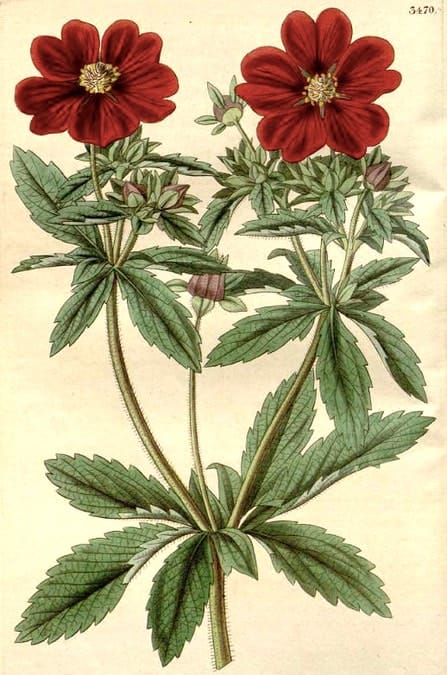Potentilla chinensis, Wei Ling Cai 委陵菜
Rgyu mkhris རྒྱུ་མཁྲིས (Tibetan Medicine)Wei Ling Cai (P. chinensis, TCM)
An Hong Wei Ling Cai (P. atrosanguinea, TCM)
 Potentilla atrosanguinea
Potentilla atrosanguineaCurtis’s Botanical Magazine, vol. 63 (1836)
Botanical name:
Potentilla spp.
Several species supply Wei Ling Cai of TCM (Bensky):
- P. chinensis (Wei Ling Cai)
- P. anserina (E Rong Wei Ling Cai)
- P. viscosa (Nian Wei Ling Cai)
- P. venusta (Rgyu mkhris ser po)
- P. atrosanguinea (Rgyu mkhris smug po)
Parts used:
Whole Plant
Temperature & Taste:
Cool, dry. Sweet, Bitter
Uses:
1. Clears Heat from the Blood, Stops Leakage: (Tibet, TCM)
-Diarrhea and Dysentery with Fever
-Diarrhea associated with Worms
-Bleeding Hemorrhoids (TCM)
2. Clears Heat, Resists Poison: (Tibetan, TCM, India)
-Cold or Flu with Fever (Tibetan, TCM, India)
-Epidemic and Contagious diseases with Heat and Toxin (Tibet)
-Pneumonia (TCM)
-Poisoning (Tibet)
-Acute Sore Throat
-Toxic Sores and Abscesses (TCM)
3. Clears Heat, Settles Wind, Stops Pain:
-Headache
-Angina Pectoris and Chest pain
4. Externally:
-applied to Toothache in Nepal.
-applied to Wounds
-applied to Toxic Sores, Abscesses, Carbuncles etc.
Dose:
Powder: 1–4 grams
Decoction: 9–15 grams
Fresh herb is decocted to use as a wash externally, or beaten to a paste for application to Sores, Abscesses etc.
Comment:
1. The Chinese variety, P. chinensis, appears to be used synonymously to the Tibetan varieties supplying Rgyu mkhris. This is also noted in the fact that both P. chinensis and P. atrosanguinea have the same name in Chinese, with the ‘An Hong‘ prefix denoting a red-flowered variety of Wei Ling Cai. A number of other species of Potentilla are used in TCM but have different names. Kletter (Tibetan Medicinal Plants) states that a number of species and varieties supply the Tibetan Rgyu mkhris.
2. Bensky lists the above three species as sources of Wei Ling Cai in TCM. However, the Encyclopedia of Traditional Chinese Medicine lists different uses for P. anserina is regarded as tonifying Qi and Blood, and strengthening Spleen and Stomach. This species is regarded as a useful tonic in Tibetan Medicine, so we have separated them .See Potentilla anserina.
Main Combinations:
1. Diarrhea, Dysentery, Potentilla venusta with Costus, Chebula
Major Formulas:
Cautions:
None noted
